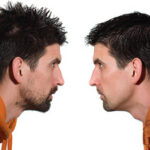Much evidence has been produced that shows that two regions of the temporal lobe, the superior temporal sulcus and the inferior temporal gyrus are composed of cells that are activated by faces. The fusiform gyrus, which is found along the ventral surface of the temporal lobe, is also referred to as the fusiform face area (FFA), and much proof is also available that confirms that it is activated when looking at faces. The FFA, found in the extrastriate cortex, functions as a unit in the visual processing of faces. The FFA may be activated in the perception of non-face stimuli, but in comparison to the significantly higher activation produced by faces, this activation is considerably small. (Gazzaniga 2002, pp. 230)
In a study researching the involvement of the FFA in face perception, fMRI was used in subjects to first decide whether any brain areas were significantly activated during the perception of faces versus the perception of objects. Areas were found in the right fusiform gyrus in almost all the subjects that were activated significantly greater when viewing faces in comparison to viewing objects. The Talairach coordinates of the regions that showed greater activation for faces in each subject was calculated to find the level of consistency in activation between the subjects and the right fusiform gyrus was subsequently chosen to be focused on in greater detail in the remainder of the experiment. The second and third part of the study dealt with ruling of alternative hypotheses which seek to deny the assertion that the FFA is specifically involved in the perception of faces and instead claim that activation of the FFA is due to reactions to the low-level features found in faces.
The second part of the study focused on the FFA of each subject ruled out luminance differences as accounting for greater activation in faces by revealing that the FFA showed a greater increase in activation when subjects viewed intact two tone faces compared to scrambled versions of the same faces. Also in Part II, subjects showed levels of activations six times greater when viewing faces in comparison to viewing houses, showing evidence of a great degree stimulus selectivity and illustrating that the FFA does not simply respond to different exemplars of the same category. In the third part the FFA in the subjects showed greater levels of activation during a consecutive matching task carried out on the three-quarter-view faces compared to the same matching task on the hand stimuli. The greater activation of the FFA during the face task compared to the hand task indicates that the activity of this region does not reflect general processes associated with either visual attention or subordinate-level classification of any class of stimuli because both tasks required subordinate-level categorization, and the hand task was at least as difficult as the face task. Overall this study contends that there not only exists an area in the fusiform gyrus that responds to faces but that this area is selectively activated and responsive to faces over other stimuli. Parts II and III of the study conclude that the FFA responds to faces rather than the low-level features that happen to be present in the face. (Kanwisher)
In a study that implemented single-cell recordings on the superior temporal sulcus of monkeys, experimenters were lead to conclude that there exists a system of neurons in the temporal lobe that are specialized to code for faces. Using single-cell recordings of 497 cells in the superior temporal sulcus in each of three rhesus monkeys a population of at least 48 cells were found that were responsive solely to faces. In the study, the monkey cell’s response to faces were two to ten times larger than those of 3-D objects, geometrical stimuli or gratings. Also, the neuronal responses to faces were excitatory and sustained in the monkeys. When tested to see if these cells were responsive to other types of stimuli, auditory, tactile, aversive and arousing stimuli were implemented, but the cells showed no response. In addition, the masking out or isolated presentation of face parts (nose, eyes, mouth and etc.) revealed that different cells responded to different features. The results of the findings of the tests from the single-cell recordings in this study show that challenging theories that seek to disconfirm the presence of any cortical machinery devoted to face perception are fallacious in their explanations in terms of arousal, emotional reactions, motor reactions, and simple visual feature sensitivity. Challengers of the theory for a preferential region for face perception cannot sufficiently account for the selective responses to different manipulations of faces and face features observed in this population neurons in the superior temporal sulcus. (Perrett 1982)
Another study that focused on FFA used fMRI to study the effect of face inversion on FFA activation. The study revealed that FFA activation was substantially reduced when faces were inverted for all subjects. An implication of the study on face inversion is that inversion leads to the disabling of the specialized face processing system in the FFA. (Kanwisher 1998) The FFA processes faces normally on a holistic level, but when a face is inverted the holistic vision of the face is destroyed and the perceiver is now forced to rely on a more analytic, low-level extraction of face parts, mode of perception. In a related study of a prosopagnosic patient, L.H., the effects of face inversion was evaluated. In prosopagnosia individuals are impaired in their recognition of the faces of familiar and unfamiliar people, however often their other intellectual capabilities and recognition abilities are spared.
Prosopagnosia is usually caused by unilateral and bilateral lesions in the temporal and occipital cortices. (Gazzaniga 227) One would expect a prosopagnosic’s ability to recognize inverted faces to be similar to a normal individuals ability to recognize an inverted face, since both normal and prosopagnosic individuals use the analysis-by-parts mode of processing in inverted faces and one would figure that prosopagnosics would do much worse than normal individuals in viewing normal faces since normal individuals maintain an undamaged and working face recognition system. The results proved these expectations to be true as L.H. was much worse at normal face recognition than normals (58% vs. 94%) and L.H. was at a more equal level of comparison with normals when viewing inverted faces (72% vs. 82%). Overall, the inversion effect further solidifies the existence of a specialized module in the brain for face perception. (Gazzaniga 2002 pp. 233)
Despite the large amount of evidence compiled concerning the specificity of the FFA in face perception there have been some studies which make the claim that the FFA does not seem to be activated solely and exclusively by faces and that the FFA may not be a specific mechanism for face recognition. For example, in a study which required judgments concerning birds and cars by bird and car experts the FFA activation was shown to be greater than a baseline condition in which no stimulus was presented. (Gauthier 2000) The increase in activation, however, is considerably trivial compared to the increase in activation produced by faces in the FFA. (Gazzaniga 2002, pp. 230) Also, the amount of evidence and strength of evidence presently available to show that the FFA is utilized for not only faces, but for all other within-category discriminations is incomparable to the variety, amount, and strength of studies that show the FFA as a special mechanism in the brain for the perception and recognition of faces.



